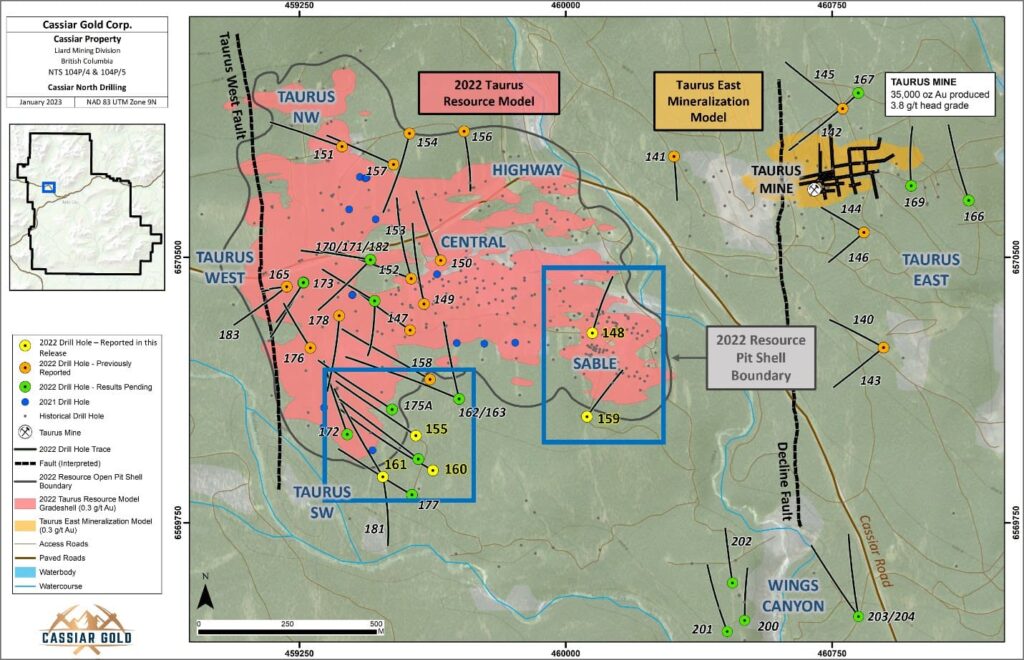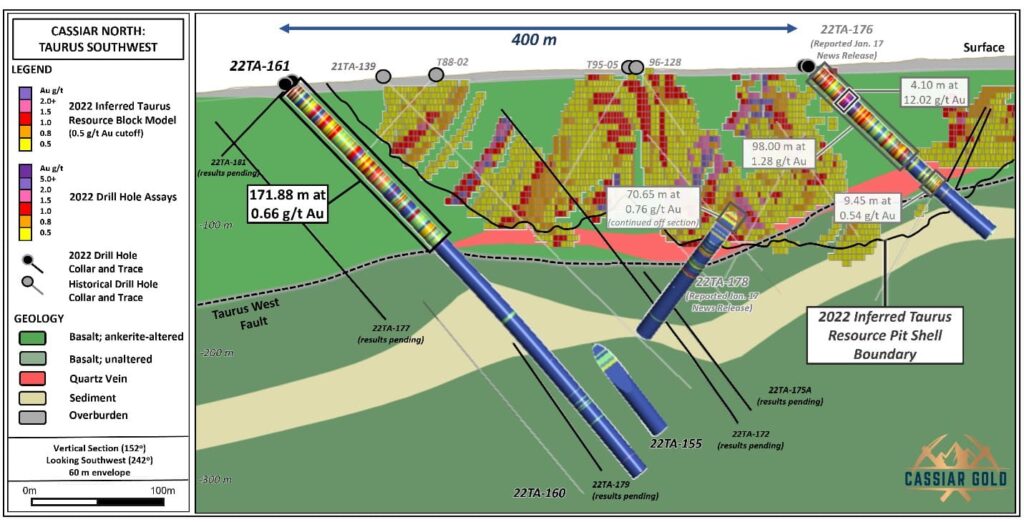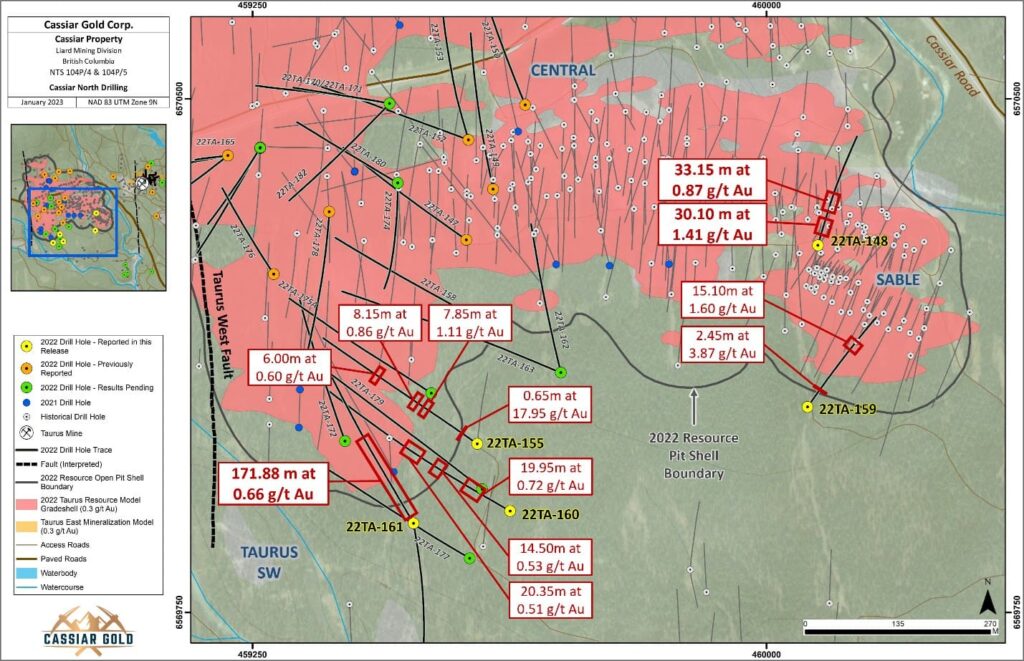Cassiar Gold Corp. announce assay results from an additional five diamond drill holes from the 2022 exploration program completed at the Taurus Deposit, located on Company’s flagship Cassiar Gold Property. The Taurus Deposit hosts a substantial near-surface, bulk-tonnage, and pit-constrained inferred gold resource of 1.4 million ounces grading 1.14 g/t Au1. Drill holes reported here are from the southwestern and southeastern (Sable) parts of the deposit (Figure 1) and were designed to outline extensions of mineralization that expand the deposit footprint and to further define mineralization continuity. The deposit remains open in all lateral directions as well as at depth.
Cassiar Gold’s 2022 program included 70 drill holes and over 23,000 m of diamond drilling that commenced in June and was completed in October 2022. Exploration focused on strategic areas of the Taurus Deposit, key vein prospects at Cassiar South and other brownfields opportunities on the property (Figure 1). Results from 45 drill holes which cumulatively total 15,314 metres of drilling from the 2022 program are yet to be disclosed as the company continues to await the return of additional assay results.
Highlights from the Taurus Southwest and Sable areas:
- Taurus Southwest drill hole 22TA-161 intersected 171.9 m of 0.66 g/t Au from surface, expanding mineralization 80 m south of previous drilling and 35 m beyond the extent of the 2022 pit constrained inferred resource model1.
- Drill hole 22TA-160 in the Taurus Southwest area returned multiple intervals of gold mineralization, extending mineralization 75 m beyond the extent of the resource model pit shell. Intercepts include:
- 20.0 m of 0.52 g/t Au from 69.0 m downhole, and
- 20.4 m of 0.51 g/t Au from 214.0 m downhole.
- Drill holes at the Sable area (22TA-148, 22TA-159) encountered multi-metre intercepts above the 2022 resource cut-off grade1, confirming historical results and extending mineralization 40 m beyond the extent of the pit constrained resource block model. Results from 22TA-148 include:
- 30.1 m grading 1.41 g/t Au from 8.7 m downhole,
- including 3.7 m of 2.76 g/t Au, and 2.4 m of 9.08 g/t Au with 0.4 m of 41.40 g/t Au; and
- 33.2 m of 0.87 g/t Au from 68.9 m downhole.
- 30.1 m grading 1.41 g/t Au from 8.7 m downhole,
“These results continue to successfully demonstrate our ongoing commitment to expanding and defining known areas of mineralization. We are very encouraged by the persistence of near surface, wide mineralized intercepts at Taurus Southwest, our widest apparent width to date,” stated Marco Roque, CEO of Cassiar Gold Corp. “Recognizing the structures critical to controlling mineralization at Taurus has directly contributed to the success of this drill program and these results now open larger areas for further exploration.”
2022 Drilling at the Taurus Deposit – Cassiar North Drill Program
The results reported in this news release are from five drill holes totaling 1,826 m from the Taurus Southwest and Sable areas of the deposit (Figure 1). They were designed to test the potential for extending known mineralization through expansion drilling, confirm historical results, and to assess the continuity of mineralization between resource blocks. Geologically, the holes were designed to evaluate the different mineralization styles which characterize the Taurus Deposit including east-west trending sheeted vein sets and minor shear zones with coalescing pyrite envelopes that together form bulk-tonnage style mineralization, as well as north-northwest trending, east-dipping disseminated pyrite mineralization along the Taurus West Fault corridor.
Drilling at the Taurus deposit continues to demonstrate consistency of grade and apparent thickness of near-surface mineralization above the inferred mineral resource 0.5 g/t Au cut-off, including over broad intervals proximal to the Taurus West Fault. These results suggest the potential for the extension of this broad mineralized corridor to continue along a much larger strike length at the southwest extent of the Taurus Deposit. The deposit remains open in all lateral directions as well as at depth.

Notes – Historical production figures from Taurus MINFILE Production Detail Report, file number 104P 012, BC Geological Survey. The Taurus East mineralization model (orange) represents upside for expansion of the deposit and was not included in the 2022 Taurus resource model (pink).
Taurus Southwest – Drill Holes 22TA-161, 22TA-160, and 22TA-155
This drilling campaign at Taurus Southwest intercepted from surface the broadest mineralized result by the Company to date in drill hole 22TA-161. This area remains open along the Taurus West Fault corridor highlighting the importance of this critical structure as a future exploration target with potential to expand the resource base.
Drill hole 22TA-161:
Drill hole 22TA-161 (northwest oriented) was designed to test for the extension of near-surface mineralization in an under-explored area proximal to the Taurus West Fault and beyond the footprint of the 2022 inferred resource. Results (Figure 2, 3; Table 1) include:
- 171.9 m of 0.66 g/t Au from surface extending mineralization 35 m beyond the boundary of the 2022 open pit constrained resource block model and 80 m southeast of previous drilling. This hole is 400 m from recently-released Taurus West drill hole 22TA-176 which returned a broad well-mineralized intercept (98.0 m of 1.28 g/t Au) along the same structural trend (Figure 2; see News Release, January 17, 2023).
This shallow mineralized corridor along the Taurus West Fault is typically characterized by high vein densities in strongly ankerite-sericite altered basalt with medium to coarse grained pyritohedrons and lesser intervals of finely disseminated pyrite mineralization. The results from this drill hole underscore the significant exploration potential along open extensions of the broad north northwest-trending Taurus West mineralized corridor outside the known footprint of the deposit (Figures 2, 3).

This drill hole steps out 80m south-southeast of previous drilling, expanding mineralization beyond the extent of the resource and highlighting continuity of broad mineralized intercepts proximal to and above the Taurus west Fault. The fault dips to the east and mineralization extends deeper in that direction on adjacent cross sections. Section width +- 30m.
Drill hole 22TA-160:
This northwest oriented drill hole further tests parts of the southern Taurus West Fault corridor in areas of widely spaced drilling southwest of drill hole 21TA-128 (see News Release, January 6, 2022). Results returned multiple intervals of gold mineralization, which extend known mineralization up to 75 m beyond the southwest extent of the pit shell model. These include (Figure 2; Table 1):
- 20.0 m at 0.72 g/t Au from 69.0 m downhole,
- 14.5 m at 0.53 g/t Au from 150.1 m downhole, and
- 20.4 m at 0.51 g/t from 214.0 m downhole.

Drill hole 22TA-155:
Drill hole 22TA-155 (northwest oriented) was designed to evaluate the eastern extension of near-surface mineralization and gaps in the mineralization model at southwest Taurus. The drill hole intersected several discrete multi-metre intercepts above the 0.5 g/t Au cutoff of the inferred resource model at moderate depths and along the Taurus West Fault. Results identified the extension of mineralization 40 m beyond the resource pit shell boundary and 135 m beyond the block model. Results include (Figure 3; Table 1):
- 7.9 m at 1.11 g/t Au, including 0.5 m at 9.82 g/t Au from 121.1 m downhole.
- 8.2 m at 0.86 g/t Au from 139.9 m downhole.
Sable area – Drill holes 22TA-148 and 22TA-159
Drill hole 22TA-148:
Drill hole 22TA-148 (northeast oriented) was designed to confirm near-surface results returned in historical drill hole T93-13, test a gap between resource blocks, and evaluate the depth of geological contacts where limited data exists. Results further defined and extended mineralization continuity across a 25 m area between resource blocks. Results include (Figure 3; Table 1):
- 30.1 m at 1.41 g/t Au from 8.7 m downhole, including 3.7 m at 2.76 g/t Au, and 2.4 m at 9.08 g/t Au with 0.4 m at 41.40 g/t Au, better defining the extent of near-surface historical results encountered in drill hole T93-13.
- 33.2 m at 0.87 g/t Au from 68.9 m downhole, including 19.5 m at 1.14 g/t Au, extending mineralization between resource blocks internal to the pit shell model.
Drill hole 22TA-159:
Drill hole 22TA-159 (northeast oriented) was designed to test the extent of mineralization associated with vein sets and associated pyritic alteration halos as a westward extension of mineralization 50 m from drill hole 20TA-116. This drill hole expands the mineralized envelope up to 40 m below the southeast portions of the resource pit shell model. (Figure 3; Table 1), Results include:
- 2.5 m of 3.87 g/t Au from 14.5 m down hole, and
- 15.1 m of 1.60 g/t Au from 136.4 m downhole, including 0.6 m of 9.04 g/t Au.
Table 1. Significant 2022 drilling results from Taurus Deposit based on a >0.5 g/t cutoff. While true thickness has not been established, drill holes are designed to cross at high to moderate angles known corridors of mineralization based on orientations of mineralized areas defined by previous drilling and structural data from oriented drill core and outcropping veins.
| Target Area | Drillhole | From | To | Length* | Grade | |
| Taurus Southwest | 22TA-155 | 41.7 | 42.3 | 0.65 m | 17.95 g/t Au | |
| 121.1 | 129.0 | 7.85 m | 1.11 g/t Au | |||
| incl. | 127.2 | 127.7 | 0.50 m | 9.82 g/t Au | ||
| 139.9 | 148.0 | 8.15 m | 0.86 g/t Au | |||
| 254.0 | 260.0 | 6.00 m | 0.60 g/t Au | |||
| 329.6 | 333.7 | 4.10 m | 0.88 g/t Au | |||
| 22TA-160 | 69.0 | 88.9 | 19.95 m | 0.72 g/t Au | ||
| 150.1 | 164.6 | 14.50 m | 0.53 g/t Au | |||
| 214.0 | 234.3 | 20.35 m | 0.51 g/t Au | |||
| 22TA-161 | 8.2 | 180.1 | 171.88 m | 0.66 g/t Au | ||
| Sable | 22TA-148 | 8.7 | 38.8 | 30.10 m | 1.41 g/t Au | |
| incl. | 8.7 | 12.4 | 3.65 m | 2.76 g/t Au | ||
| and | 21.5 | 23.9 | 2.35 m | 9.08 g/t Au | ||
| with | 23.0 | 23.4 | 0.35 m | 41.40 g/t Au | ||
| 68.9 | 102.0 | 33.15 m | 0.87 g/t Au | |||
| incl. | 68.9 | 88.3 | 19.45 m | 1.14 g/t Au | ||
| 22TA-159 | 14.5 | 16.9 | 2.45 m | 3.87 g/t Au | ||
| 136.4 | 151.5 | 15.10 m | 1.60 g/t Au | |||
| incl. | 147.4 | 148.0 | 0.60 m | 9.04 g/t Au | ||
| * Drill core lengths are reported here. True widths for these intervals have not been established | ||||||
Qualified Person
The technical information in this news release has been reviewed and approved by Jill Maxwell, P.Geo., Cassiar Gold Corp.’s Exploration Manager, who is a Qualified Person as defined by National Instrument 43-101.
Quality Assurance (QA) and Quality Control (QC)
The 2022 Cassiar drilling program comprises HQ drill core oriented using the REFLEX ACTIII system. Drill core samples are selected and logged by geologists prior to being cut in half using a diamond cutting saw at a secure facility located in Jade City, British Columbia. Certified gold reference standards and blanks are routinely inserted into the sample stream as part of the Company’s QA/QC program. All samples are delivered to the ALS Global preparation facility in Whitehorse, Yukon, where they are processed, and then shipped to the ALS Global analytical facility in North Vancouver, British Columbia. Samples are analyzed for gold by 50-gram fire assay with finish by atomic absorption or gravimetric methods. Screen metallic analysis is performed on selected samples. ALS Global quality systems and technical aspects conform to requirements of ISO/IEC Standard 17025 guidelines.
About Cassiar Gold Corp.
Cassiar Gold Corp. is a Canadian gold exploration company holding a 100% interest in its flagship Cassiar Gold Property located in British Columbia, Canada. The Cassiar Gold property spans 590 km2 and consists of two main project areas: Cassiar North, which hosts a NI 43-101-compliant inferred resource estimate of 1.4Moz at 1.14 g/t Au (cutoff grade of 0.5 g/t Au) known as the as the Taurus Deposit (see National Instrument 43-101 Technical report on the Cassiar Gold property, April 28, 2022, by S. Zelligan, J. Moors, C. Jolette, posted to SEDAR); and Cassiar South which hosts numerous gold showings, historical workings, and exploration prospects. Historical underground mines in the Cassiar South area have yielded over 315,000 oz of Au at average head grades of between 10 and 20 g/t Au (2017, Cowley2), underscoring the high potential for further discovery and expansion of high-grade orogenic gold veins.
The Company also holds a 100% interest in the Sheep Creek gold camp located near Salmo, BC. The Sheep Creek gold district ranks as the third largest past-producing orogenic gold district in BC with historical gold production of 742,000 ounces gold at an average grade of 14.7 g/t gold from 1900 to 1951. Minimal exploration work has been conducted since the 1950s.
Cassiar Gold Corp. acknowledges, respects, and supports the rights of Traditional First Nations in the lands and communities where we operate.
CONTACT INFORMATION
Cassiar Gold Corp.
E-mail: [email protected]
Phone: 236-878-6160













